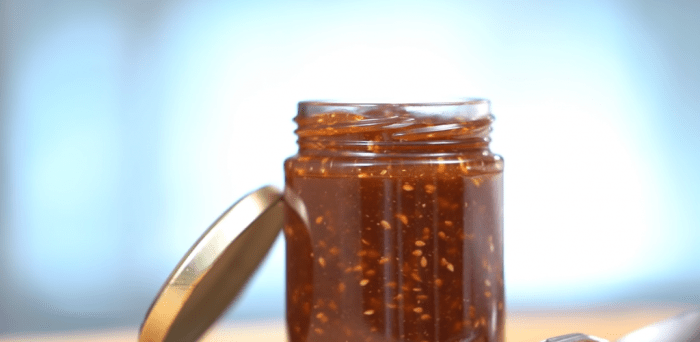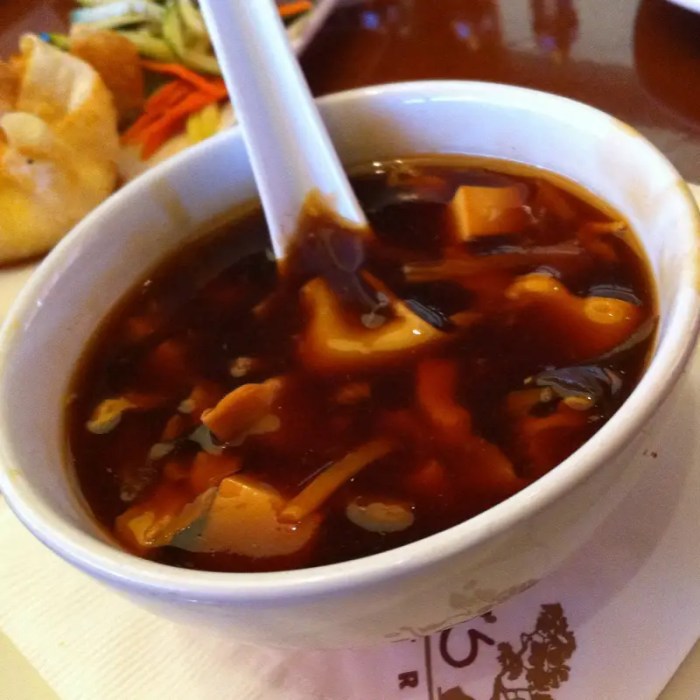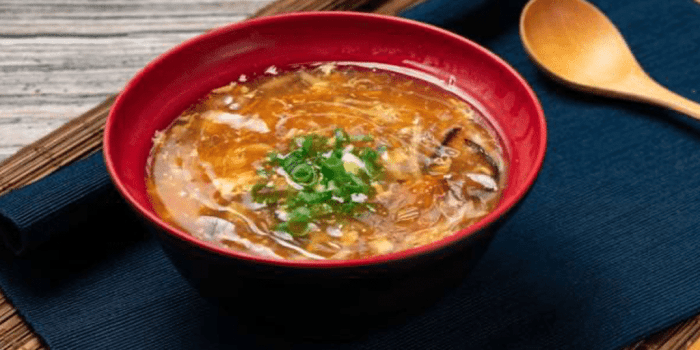Understanding P.F. Chang’s Hot & Sour Soup: Pf Chang’s Hot Sour Soup Recipe
Pf chang’s hot sour soup recipe – P.F. Chang’s Hot & Sour Soup is a popular appetizer known for its vibrant flavors and satisfying texture. It’s a complex dish, balancing the contrasting tastes of heat and tanginess, achieved through a careful combination of ingredients and cooking techniques. This analysis delves into the key components of this iconic soup.
Key Characteristics of P.F. Chang’s Hot & Sour Soup
The soup is characterized by its bright, slightly oily appearance, a rich and complex broth, and a generous amount of ingredients that add textural depth and flavor complexity. The balance between hot and sour is crucial, with a pleasant lingering warmth and a sharp, refreshing sourness. The overall taste is umami-rich and savory, with a subtle sweetness that complements the other flavors.
Main Ingredients and Proportions

Source: recipes.net
While the exact proportions are proprietary, a typical recipe includes a flavorful broth (often chicken or vegetable based), wood ear mushrooms, silken tofu, bamboo shoots, scallions, chili garlic sauce, rice vinegar, and soy sauce. The mushrooms and tofu contribute a substantial portion of the overall volume, while the sauces provide the characteristic hot and sour flavors. Proportions vary depending on the recipe, but the broth typically forms the base, with the remaining ingredients contributing in smaller, but equally important, quantities.
Balance of Hot and Sour Flavors

Source: secretcopycatrestaurantrecipes.com
The balance between hot and sour is carefully calibrated. The “hot” comes primarily from chili garlic sauce and potentially added chili flakes, while the “sour” is provided by rice vinegar and sometimes a touch of lime juice. The intensity of both flavors can be adjusted to individual preference. A well-balanced recipe ensures that neither flavor overwhelms the other, creating a harmonious and exciting gustatory experience.
Texture and Consistency
The soup has a relatively thin consistency, allowing for easy consumption. The ingredients are generally finely chopped or sliced, contributing to a pleasant mouthfeel. The tofu adds a soft, yielding texture, while the mushrooms offer a slightly firmer bite. The overall texture is not overly thick or heavy, contributing to the soup’s refreshing quality.
Recipe Variations and Adaptations
Numerous online recipes attempt to replicate P.F. Chang’s Hot & Sour Soup, each with its own variations and adaptations. These variations often reflect the availability of ingredients, personal preferences, and culinary creativity.
Comparison of Online Recipes
Many online recipes share core ingredients, but differ in the specific types and quantities used. Some recipes might emphasize spicier notes, while others focus on a more pronounced sourness. The type of broth also varies, with some using chicken broth for a richer flavor and others opting for vegetable broth for a lighter alternative. These differences lead to a wide spectrum of taste profiles, all attempting to capture the essence of the original dish.
Broth Variations, Pf chang’s hot sour soup recipe
Using different broths significantly impacts the soup’s flavor profile. Chicken broth provides a richer, more savory base, while vegetable broth offers a lighter, vegetarian-friendly alternative. Even bone broth could be used for a deeper, more umami-rich experience. The choice of broth depends entirely on personal preference and dietary restrictions.
Adjusting Spice and Sourness
The spice level can be easily adjusted by controlling the amount of chili garlic sauce and/or adding chili flakes. Similarly, the sourness can be modified by adjusting the amount of rice vinegar or lime juice. Starting with smaller quantities and gradually increasing to taste is recommended to achieve the desired balance.
Ingredient Substitutions
Certain ingredients, like specific types of mushrooms, might be difficult to find. Wood ear mushrooms can be substituted with shiitake or oyster mushrooms, though the texture and flavor will slightly differ. Similarly, if silken tofu is unavailable, firm tofu can be used, but it will require a different preparation method (e.g., pressing and cubing instead of crumbling).
Ingredient Sourcing and Preparation
Using high-quality ingredients is crucial for achieving the best flavor and texture. Proper preparation techniques further enhance the overall quality of the soup.
Sourcing High-Quality Ingredients
Look for fresh, high-quality mushrooms from reputable suppliers. Choose a chili garlic sauce with a vibrant red color and a noticeable aroma. Fresh scallions and high-quality soy sauce and rice vinegar are also key for optimal flavor.
Ingredient Preparation Techniques
Mushrooms should be thoroughly cleaned and thinly sliced. Silken tofu is typically crumbled directly into the soup. Bamboo shoots should be rinsed and finely chopped or sliced. Scallions should be finely chopped, separating the white and green parts for different additions during cooking.
Ingredient List and Preparation
| Ingredient | Quantity | Preparation Notes | Substitutions |
|---|---|---|---|
| Chicken Broth | 6 cups | Use low-sodium broth for better flavor control. | Vegetable broth |
| Wood Ear Mushrooms | 1 cup, dried | Rehydrate in warm water for 30 minutes, then thinly slice. | Shiitake or oyster mushrooms |
| Silken Tofu | 1 block (14 oz) | Crumble into the soup. | Firm tofu (pressed and cubed) |
| Bamboo Shoots | 1/2 cup, sliced | Rinse well before using. | N/A |
| Scallions | 4, chopped (separate white and green parts) | Use both white and green parts for layered flavor. | N/A |
| Chili Garlic Sauce | 2 tablespoons | Adjust to taste. | Sriracha or other chili sauce |
| Rice Vinegar | 2 tablespoons | Adjust to taste. | White wine vinegar |
| Soy Sauce | 1 tablespoon | Use low-sodium soy sauce. | Tamari |
| Cornstarch | 1 tablespoon | Mixed with cold water to create a slurry. | Arrowroot powder |
| Ginger | 1 tablespoon, minced | Fresh ginger preferred. | Ground ginger |
| Garlic | 2 cloves, minced | Fresh garlic preferred. | Garlic powder |
Visual Representation of Ingredient Preparation
Imagine a series of close-up shots. The first shows the dried wood ear mushrooms soaking in a bowl of warm water. The next shows the thinly sliced mushrooms, followed by a shot of the silken tofu being crumbled. Then, a view of the finely chopped bamboo shoots, followed by the scallions being chopped separately. Finally, a shot showcasing the various sauces and spices ready for use.
Cooking Methods and Procedures

Source: elgeniodelshawarma.com
While P.F. Chang’s hot and sour soup boasts a vibrant, tangy profile, a contrasting creamy option might appeal to some. For those seeking a different kind of comfort, consider the richness of a panera cream of chicken wild rice soup recipe ; its comforting warmth offers a nice change of pace. Ultimately, both soups highlight the versatility of flavorful broths, showcasing distinct culinary approaches.
The cooking process for P.F. Chang’s Hot & Sour Soup involves several steps to create a flavorful and balanced dish. Precise timing and temperature control are essential for achieving the desired texture and flavor profile.
Step-by-Step Cooking Process
- In a large pot or Dutch oven, heat a tablespoon of oil over medium heat. Add minced ginger and garlic; sauté for about 30 seconds until fragrant.
- Add the white parts of the chopped scallions and sauté for another minute until softened.
- Pour in the chicken broth and bring to a simmer. Add the rehydrated and sliced wood ear mushrooms and bamboo shoots. Simmer for 5-7 minutes.
- Stir in the chili garlic sauce, rice vinegar, and soy sauce. Adjust the seasoning according to your preference.
- In a small bowl, whisk together the cornstarch and cold water to create a slurry. Slowly pour the slurry into the simmering soup, stirring constantly to prevent lumps. Continue to simmer until the soup slightly thickens.
- Gently stir in the crumbled silken tofu. Heat through for about 2-3 minutes.
- Stir in the green parts of the chopped scallions just before serving.
- Serve hot.
Serving Suggestions and Enhancements
The ideal presentation and serving temperature significantly impact the overall dining experience. Careful consideration of these aspects elevates the soup from a simple dish to a culinary delight.
Serving Temperature and Garnishes
Serve the soup piping hot in individual bowls. Garnishing with extra chopped scallions and a drizzle of chili oil adds visual appeal and enhances the flavor. A sprinkle of toasted sesame seeds can also provide a delightful textural contrast and nutty flavor.
Complementary Side Dishes
P.F. Chang’s Hot & Sour Soup pairs well with various appetizers and side dishes. Spring rolls, potstickers, or even a simple side salad provide a balanced and satisfying meal. The soup’s bright flavors complement the richness of many Asian-inspired dishes.
Enhancing Presentation
Serving the soup in elegant bowls enhances its visual appeal. Consider using contrasting colors in the garnishes, such as bright green scallions against the reddish-brown soup. A simple, clean presentation allows the soup’s vibrant colors and ingredients to stand out.
Optimal Serving Time
The soup serves best as an appetizer, stimulating the appetite before a larger meal. Serving it at the beginning of the meal allows the diners to enjoy its refreshing flavors without feeling overly full before the main course.
Nutritional Information and Considerations
While exact nutritional values depend on specific ingredients and quantities, an estimated nutritional profile provides a general understanding of the soup’s nutritional content and potential dietary considerations.
Estimated Nutritional Content per Serving
| Nutrient | Approximate Value (per serving) |
|---|---|
| Calories | 200-250 |
| Protein | 10-15g |
| Carbohydrates | 20-25g |
| Fat | 5-10g |
Note: These values are estimates and may vary depending on the specific ingredients and quantities used.
Potential Allergens
This soup may contain allergens such as soy (from soy sauce), wheat (if using a wheat-based broth), and sesame (if using sesame oil or seeds). Always check ingredient labels carefully.
Dietary Adaptations
For a vegetarian version, simply use vegetable broth instead of chicken broth. For a vegan version, ensure all ingredients (including the broth and any potential additives) are plant-based. A low-sodium version can be made by using low-sodium broth and soy sauce, and reducing or omitting added salt.
Clarifying Questions
Can I make this soup vegetarian/vegan?
Yes, easily. Omit the chicken broth and use vegetable broth instead. For a vegan version, ensure all other ingredients are also plant-based.
How long does the soup keep?
Store leftovers in an airtight container in the refrigerator for up to 3 days.
Can I freeze this soup?
Yes, it freezes well. Allow it to cool completely before freezing in airtight containers for up to 2 months.
What if I don’t have all the ingredients?
Many ingredients can be substituted. See the recipe for suggested alternatives.
What’s the best way to adjust the spice level?
Start with less chili garlic sauce and add more to taste. You can also adjust the amount of chili flakes.
